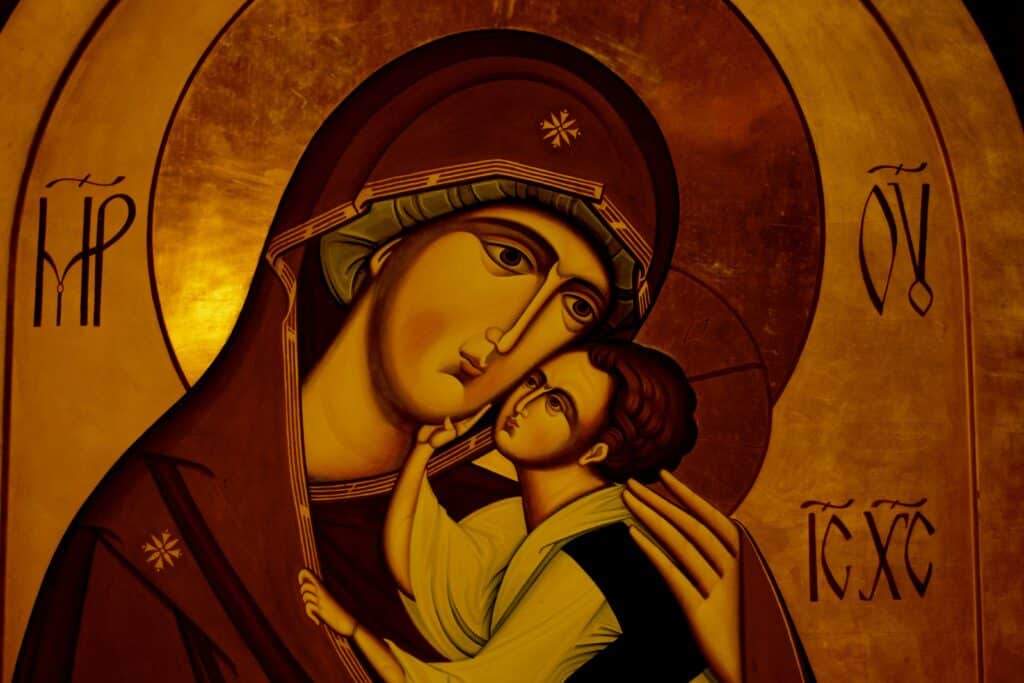We’re used to communicating to God through words, but images have a special power.
For many of who were raised Catholic, icons—religious portraits of people and scenes from Scripture painted on specially prepared wood using prescribed materials and techniques—seem primitive and dark, sad and austere, and we gravitate instead toward brighter, more familiar images. Because we don’t understand them, we dismiss icons as something belonging to another tradition, something that somebody else believes in, something that has nothing to do with us. Yet their tradition is rich, steeped in centuries of a complex and profound spirituality, and to dismiss it is to close the door on one of the most ancient and enduring ways of experiencing God: using icons in prayer.
The word icon means “image,” and images are powerful. It’s not accidental that the phrase “a picture is worth a thousand words” came into being. But to use an icon in your prayer life isn’t simply to use a picture as a focus; that would be called art appreciation. To use icons in your prayer life is to open yourself to various access points to God, using not only your mind but all your senses, recognizing that the icon can be as valid a medium of revelation as the printed word—and often a more powerful one.
There’s another dimension to praying with icons. It is, in a sense, to call forth and be a part of the centuries of tradition to which they belong, to become part of that shining stream of intuitive spirituality that speaks directly to the heart, to be the connection between the community of the past and the community of the future.
To pray with an icon is to place yourself inside a legacy of spirituality, to answer the question, “Where do I come from?” To pray with an icon is to summon up a whole tradition of prayer and fasting, of meditation and liturgy and life that transcends anything that any one person can experience alone. It’s to claim the legacy of martyrs, scholars, monastics, bishops, and saints: it is to claim the lives of our people.
Choosing an Icon
So you have made the decision to use icons in your own prayer life. You first need to find an icon that holds some meaning for you, some beauty for you, some point of contact.
How do you choose an icon? Where do you begin? With whom? Actually, the point is less whom the icon is depicting than how the icon affects you. You are an integral part of the experience; using a certain icon because it’s famous, or because someone else likes it, is to deny your contribution to the event, your unique presence in it.
You are not, after all, going to be praying to the icon itself; you will be praying through it—to God. In that sense, it’s just a tool. So don’t feel that the icon has to depict a certain person or scene from Scripture in order to “work.” It isn’t the icon that will do the work, but you.
Some people know at once which icon to use; there’s a moment of recognition, a sensation deep in the heart. But for most of us who were raised in a Western spiritual tradition, it takes time for the icon to penetrate the layers of intellectual and social conditioning and speak to the heart; so often it’s necessary to sit with an icon for a time and see what happens.
If you don’t already have a favorite icon, you might try several that you can find in books, calendars, and holy cards. Spend time with each of these icons and see which ones you find yourself returning to. They may not be the most beautiful ones, but they will hold some meaning for you. Feel free to experiment.
The Challenge to Do Nothing
Let’s say you’ve selected an icon. Now what do you do? Nothing. That is the real, the primary, truest, and most difficult answer to that question: you do nothing.
To pray with an icon is to understand that prayer has less to do with our intellect than it has to do with our heart, less to do with talking than with listening, less to do with doing than with being. And in a rushed and technological world where speed and production are qualities to be prized, this is a difficult concept to accept.
It’s not our fault, not really. Catholics have inherited, for better or for worse, the rationalism that characterized the Reformation and Counter-Reformation movements: the sense that God is accessible primarily through the mind. But we’re recapturing a more Eastern
Orthodox way of accessing God, as well, through a wide range of media: through our ears as we listen to beautiful music, through our eyes as we contemplate religious art, through our sense of smell as we breathe in the rich odor of incense. God is accessible through all our senses, and touching God through art or music is just as valid as touching God through Scripture.
We don’t need to understand in order to love. This dichotomy is most evident in our prayer life. Catholics perceive prayer as being primarily something that one does. One comes to prayer times, frequently, with an agenda: I’m going to pray for this; I’m going to pray about that. And then we proceed to talk to God. Conversation finished (at least on our part), we get up, dust off our knees, and go about our business.
For an Eastern Christian, prayer is not something that we do, but rather something that we receive. Prayer involves waiting rather than doing, listening rather than talking. What you are doing is not divorced from the rest of your faith life, but rather, it is your faith life, the center of your spirituality. The icon is the prayer.

Praying with Mary, the Theotokos
We’re going to look at praying with the Theotokos, the Eastern Orthodox way of conceptualizing Mary, which means “God-bearer.” You can, of course, adapt this introduction and guiding questions to any icon you choose.
Look at the color first. How does the deep red strike you? Is it peaceful? Does it touch your senses? What about the gold surrounding the figures? What feelings does the gold bring into your awareness? Look at how the Theotokos holds the Christ Child. See how gentle her touch is, yet how firm her grasp. Can you feel those arms around you, holding you, encircling you with love?
Look at her eyes: What can you read there? What is she saying to you? What is she asking of you? What questions come into your heart as you look at her eyes? See the Christ Child. He is not simply a baby, but a king. Can you feel the tenderness between this mother and child? What feelings does that tenderness bring forth in you? See the eyes of the child. What is he saying to you today?
Move your gaze around the icon; see everything that there is to see. Close your eyes and breathe for a few moments. What images are imprinted on your eyes? Open your eyes again and look at the icon.
Where are you drawn now? Why? What is it in this icon that is touching you? Move now beyond your own feelings. Is there joy in this image? Do you see sorrow? Pain? What feelings are reaching deep into your heart as you gaze at the figures pictured?
Notice, again, the Christ Child in this icon. He is larger than life, not the sleeping baby of Western manger scenes. You will see that he wears gold, the color of royalty: this is Christ crowned king, already. He is already alive, already dying, already risen; it is there in his eyes, and the love that enabled that life. Yet he looks at us with great vulnerability. (Those icons of the Theotokos that show the Christ Child’s full body also show one of his feet turned so that we can see its sole, emphasizing that same vulnerability—and that same accessibility to us.)
The cheek of the Christ Child is pressed up against his mother’s cheek; you can see a great tenderness, a great closeness there. What does that say to you now? How does it feel? Can you, too, find in this icon an access point to some of that same tenderness?
When you need comfort, summon this image to your mind. It is there for you. Just as the Theotokos comforts the Christ Child, so, too, do her eyes invite you in to receive that same comfort, that same tenderness, that same love. When my own mother died, I realized just how much it had meant to have her only a telephone call away; when I was hurt or afraid, I would call just to hear her voice.
Somehow, that made everything seem more controllable. We have that same offer here: she will not solve our problems for us, but she will help us put them in perspective—she will show us that they are controllable. If you are hurt or afraid or tired, the icon of the Theotokos is there for you. Her ear is attentive. Her eyes understand. And her hand touches Christ.
Steps to Begin Praying with an Icon
✦ Start by making yourself comfortable. Kneeling may be your first inclination, but it would be better, especially at first, to be seated in a comfortable position with the icon situated just below eye level, so you don’t have to strain to look at it.
✦ Wear clothes that are loose fitting and appropriate to the temperature—anything that is bothersome (tightness, too much cold or heat) will keep part of your consciousness focused away from what you are doing.
✦ Light candles or incense, if you like; but mostly focus your attention on the icon. Explore it with your eyes and feelings. Pause and consider the feelings that it brings up in you.
✦ Silence is an integral feature of Orthodox spirituality. You will see very quickly: there is no icon that encourages a torrent of words, a rushed prayer or two. Icons slow us down by their very serenity; they require, first and before all else, our silence. If there can be no silence, then there can be no prayer because prayer is formed by silence, fashioned by it, led into and through it. It’s not our silence that we are experiencing—it is the silence of God.
✦ Sit with the icon as long as you can, really looking at it, really seeing it. If you find that you need words, the simplicity of the Jesus Prayer is appropriate: “Lord Jesus Christ, Son of God, have mercy on me, a sinner.” If you use this prayer, repeat it several times, slowly, rhythmically, and then come back to sitting in silence. There are voices all around you; you have only to still yourself to hear them.
✦ Practice is essential: you won’t be completely comfortable the first, or the second, or perhaps even the 10th time that you sit with your icon. You have to begin to unlearn what you have been taught all your life—that factual truth is important. Spiritual truth is far more important here; and spiritual realities touch you in unfamiliar ways. Let them do so. Let new feelings grow inside you. Let the icon speak.







